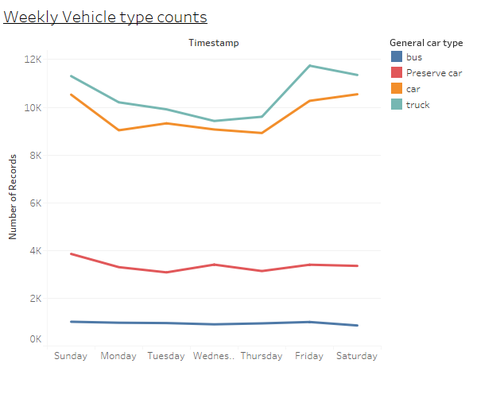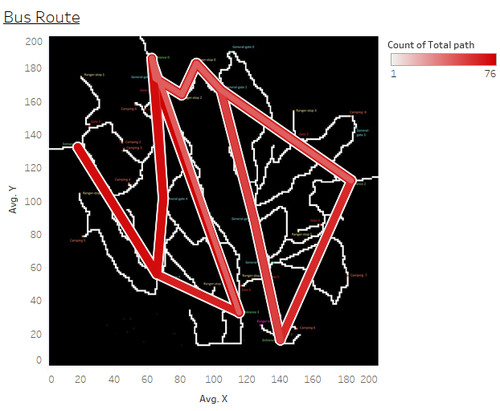ISSS608 2016-17 T3 Assign WANG YINGBEI
Contents
VAST Challenge 2017: Mini-Challenge 1
As part of his investigation, ornithology student Mitch Vogel needs to examine the movement of traffic through the Boonsong Lekagul Nature Preserve. His first working hypothesis is that there is some link between the traffic going through the preserve and the decline in the nesting Rose-crested Blue Pipit—maybe the traffic noises are drowning out mating calls! Or perhaps he can discover some odd goings on in the traffic patterns—perhaps campers are invading the bird’s habitat areas?
There are park rangers working as caretakers of the nature preserve, and they have been collecting traffic data for their annual reporting to the local government. They have provided Mitch with some data, explanations about the data, and a map. Mitch feels unprepared to analyze this information alone and is asking you to help with your visual analytics prowess.
Use visual analytics to analyze the available data and develop responses to the questions below. In addition, prepare a video that shows how you used visual analytics to solve this challenge. Novel visual Insert non-formatted text here visualizations and analysis approaches are especially interesting for this mini-challenge. Please do not use any other data in your work (including other Internet-based sources or other mini-challenge data).
Questions
- “Patterns of Life” analyses depend on recognizing repeating patterns of activities by individuals or groups. Describe up to six daily patterns of life by vehicles traveling through and within the park. Characterize the patterns by describing the kinds of vehicles participating, their spatial activities (where do they go?), their temporal activities (when does the pattern happen?), and provide a hypothesis of what the pattern represents (for example, if I drove to a coffee house every morning, but did not stay for long, you might hypothesize I’m getting coffee “to-go”). Please limit your answer to six images and 500 words.
- Patterns of Life analyses may also depend on understanding what patterns appear over longer periods of time (in this case, over multiple days). Describe up to six patterns of life that occur over multiple days (including across the entire data set) by vehicles traveling through and within the park. Characterize the patterns by describing the kinds of vehicles participating, their spatial activities (where do they go?), their temporal activities (when does the pattern happen?), and provide a hypothesis of what the pattern represents (for example, many vehicles showing up at the same location each Saturday at the same time may suggest some activity occurring there each Saturday). Please limit your answer to six images and 500 words.
- Unusual patterns may be patterns of activity that changes from an established pattern, or are just difficult to explain from what you know of a situation. Describe up to six unusual patterns (either single day or multiple days) and highlight why you find them unusual. Please limit your answer to six images and 500 words.
- What are the top 3 patterns you discovered that you suspect could be most impactful to bird life in the nature preserve? (Provide a short text answer.)
Pattern Uncover & Analysis
1. Daily Pattern
| Index | Visualization | Findings |
|---|---|---|
| 1 | The most vehicles come to the preserve is from Type1. Followed by type2 and type3. This indicates that most of cars coming to the park is to take passengers into the park. The coming rate of Type 1 vehicles has climbed up a bit from 7-10pm. | |
| 2 | The most active sensors are for general gates, as general gate sensors are built for rangers to monitor the traffic flow in the park Ranger sensors are the second active sensors which are set to monitor the traffic flow in the ranger stops. Its high flow may be due to rangers duty. | |
| 3 | Ranger Schedule: Rangers are free from work from 4-5am everyday. Moreover, they have extra 1 hour from 3am from Monday to Wednesday, 2 hour from 2am for Thursday and 3 hour from 1am for Saturday. | |
| 4 | ||
| 5 | Example | |
| 6 | Example |
2. Multiple Days Pattern
| Index | Visualization | Findings |
|---|---|---|
| 1 | Example | |
| 2 | Example | |
| 3 | Example | |
| 4 | Example | |
| 5 | Example | |
| 6 | Example |
3. Unusual Pattern
| Index | Visualization | Findings |
|---|---|---|
| Example | Example | |
| Example | Example | Example |
| Example | Example | Example |
| Example | Example | Example |
| Example | Example | Example |
| Example | Example | Example |










